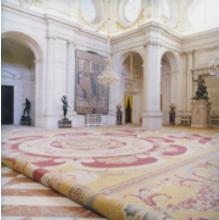Candida Hofer
dal 24/1/2005 al 17/4/2005
Segnalato da
24/1/2005
Candida Hofer
University Art Museum, Long Beach
Architecture of Absence. For over thirty years, Hofer has been photographing rooms in public places that are centers of cultural life, such as libraries, museums, theatres, cafes, waiting rooms, universities, and churches. This exhibition deals specifically with the artist's architecture of interior spaces–public or institutional facilities–wherein the human presence is largely absent. Included in the exhibition will be approximately forty new works that are still in progress

The University Art Museum is pleased to present German artist Candida Höfer in her first United States retrospective. Candida Höfer: Architecture of Absence will be on view from January 25 to April 17, 2005. Ms. Höfer will make a personal appearance at the UAM on Saturday, February 26, for a special meet the artist reception. The exhibition includes fifty photographs and is accompanied by a seminal catalogue published by the Aperture Foundation which includes essays by Constance W. Glenn, Emeritus Director of the University Art Museum; Mary-Kay Lombino, Curator of Exhibitions at the University Art Museum; and Virginia Heckert, William and Sarah Ross Sofer Curator of Photography at the Norton Museum of Art.
For over thirty years, Candida Höfer has been photographing rooms in public places that are centers of cultural life, such as libraries, museums, theatres, cafés, universities, and historic houses and palaces. Among the unique aspects of Höfer s work is the fact that typically the people who would inhabit these spaces are absent, thus enabling her to discover in the spaces what she describes as an almost magical presence of things. The University Art Museum is pleased to present Candida Höfer: Architecture of Absence, the artist s first retrospective in the United States. In conjunction with the Norton Museum of Art, West Palm Beach, Florida, and Aperture Foundation, New York, the monograph Candida Höfer: Architecture of Absence will accompany the exhibition. This is the first major English-language publication devoted to Höfer s work. It features a collection of fifty color photographs, which embraces the full spectrum of her illustrious career with an emphasis on new work made over the past two years. The book and accompanying exhibition mark the most significant North American exposure to date for this celebrated German artist.
In looking at Höfer s work, the viewer can revel in the exquisite detail of her meticulously composed images, which are infused with the richness and vibrancy of implied human activity. Whether they display symmetrical bookshelves at a national library or the lobby of a trendy hotel, Höfer s images ask us to conduct a distanced examination through the window she has created. Moved by the uncommonly beautiful aspects of her depiction of interior architecture, one becomes intensely aware of a precisely conceived environment imbued with light and order. Seen as a group, her rhythmically patterned images present a universe of interiors wholly constructed by human intention, unearthing the patterns of order, logic, and disruption imposed on these spaces by their now absent creators and inhabitants.
The New York Times art critic Michael Kimmelman writes, "Ms. Höfer is a straight photographer whose humanity and improvisatory spirit come across if we are patient enough to appreciate the serendipity of her light, the subtlety of her color and the quiet, melancholy pleasure she seems to take in finding, as if almost by chance, poetry in institutional form."
Candida Höfer is the senior member of the Becher circle, the first class of students including Thomas Ruff, Thomas Struth, Andreas Gursky, and Axel Hütte to study at the Dusseldorf Academy under the tutelage of renowned professor Bernd Becher in the 1970s and 1980s. The work that emanated from the academy, considered the most influential German art school of the time, and Becher s classes, soon took the art-photography world by storm. Since 1975, she has had solo exhibitions in galleries and museums throughout Europe and the United States, including the Hamburger Kunsthalle, Germany; the Kunsthalle Basel, Switzerland; the Centre Photographique d lle de France; Rena Bransten Gallery, San Francisco; Johen & Schottle, Cologne; and Sonnabend Gallery, New York. She has participated in group exhibitions at the Museum of Modern Art, New York; the Kunsthaus Bregenz; the Museum Ludwig, Cologne; and Documenta 11. She recently represented Germany at the Venice Biennale (together with the late Martin Kippenberger) and is represented by many galleries in Europe and the United States.
The accompanying hardcover publication, Candida Höfer: Architecture of Absence, is the first major English-language examination of Höfer s work. The publication features over 50 color plates and three insightful, illustrated essays by Constance W. Glenn, Emeritus Director of the University Art Museum; Mary-Kay Lombino, Curator of Exhibitions at the University Art Museum; and Virginia Heckert, William and Sarah Ross Sofer Curator of Photography at the Norton Museum of Art, who place Höfer s work in critical context and compare and contrast it to the work of her mentors, Bernd and Hilla Becher, as well as her fellow students, and those artists whose work influenced or inspired them.
Sarah G. Vinci, Director of Publications & Public Relations, 1250 Bellflower Boulevard, Long Beach, CA 90840 Telephone 562.985.5761 Fax 562.985.7602
Image: Candida Höfer, Palacio Real Madrid XI 2000, 152 x 152 centimeters, c-print, Collection University Art Museum, California State University, Long Beach. Copyright © 2004 Candida Höfer/Artists Rights Society (ARS), New York.
University Art Museum
College of the Arts California State University, Long Beach
1250 Bellflower Boulevard Long Beach, CA 90840
Hours: Tuesday - Friday 12 to 5 PM, Thursday to 8 PM
Saturday & Sunday 11 to 4 PM



